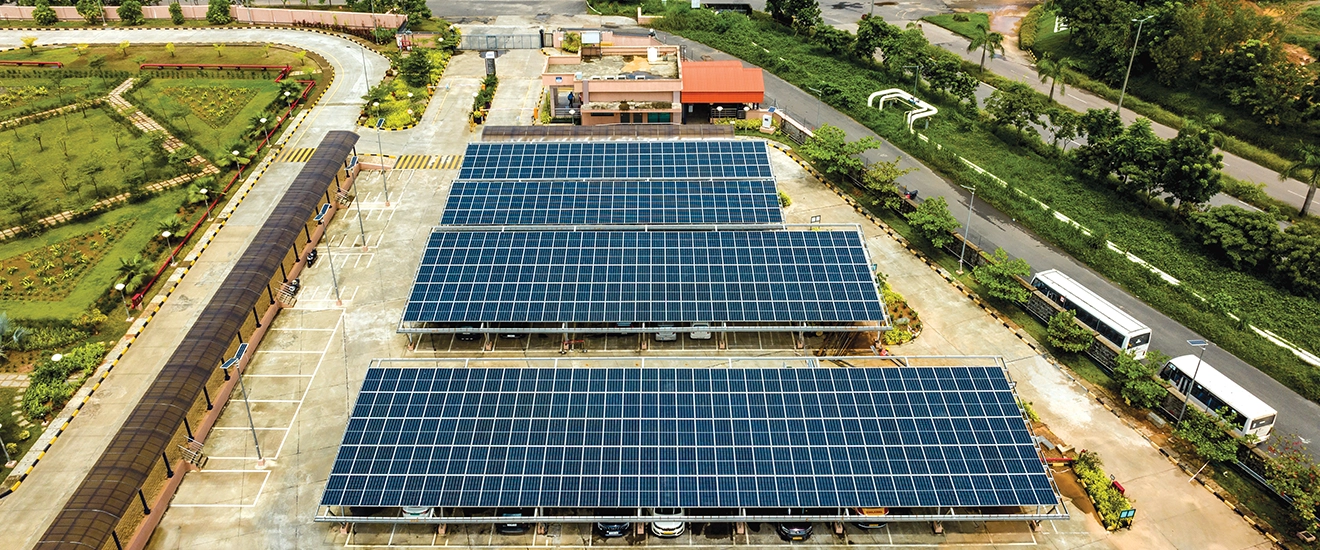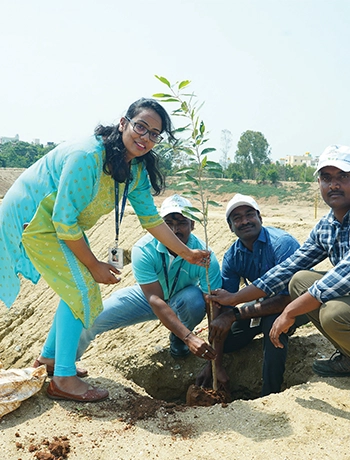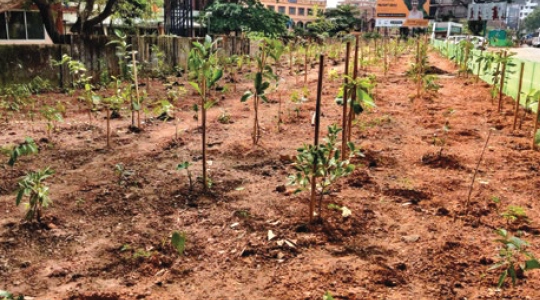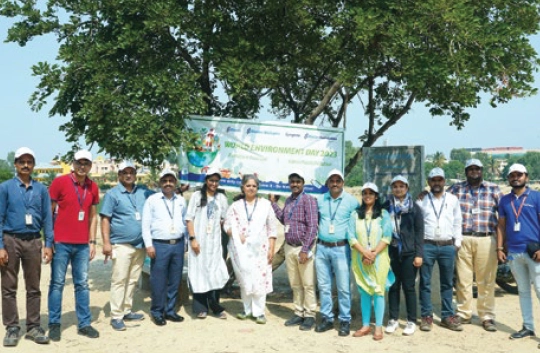

We believe that sustainable business growth can only be achieved by actively identifying and managing environmental considerations. Our dedication to resource conservation in the areas of energy, water, and waste - including co-processing activity for energy recovery - is a testament to our commitment to sustainable business practices. During the year, we explored new avenues and technologies to help minimize our environmental impact through improving energy efficiency, effective waste management, discharge control, and the protection of valuable resources.
We have set ambitious targets for energy and water use, emissions and waste reduction as well as seeking energy and resource-saving initiatives across the entire value chain, from drug discovery through to manufacturing. In addition, we have compiled an inventory of our Scope 3 greenhouse gas emissions which means that our environmental ambitions can be extended to include the suppliers who work with us. Over the long term, our aim is to protect and restore natural resources to maintain a healthy planet for future generations.
The Company is dedicated to preserving the environment and has established a strong system of governance to achieve this goal.
An Environmental Management System (EMS) underpins our operating environment. The EMS helps to ensure coordination across our plans for overall resource conservation and waste reduction. This, in turn, helps to further improve our environmental compliance and reduce operating impacts on the environment. Our EMS has achieved ISO 14001:2015 certification. The EMS is audited regularly, with the last surveillance audit conducted in November 2023.
Our team of Environment, Health, Safety and Sustainability (EHSS) professionals provide expert advice to the in-house engineering team and operational divisions to identify new ways to improve resource efficiency and minimize environmental impact. The EHSS team monitors environmental metrics to drive continuous improvement and shares best practices across Syngene.
The Executive Committee oversees and provides assurance to the Board concerning strategic, operational, and emerging environmental risks each quarter using an Enterprise Risk Management framework. This approach ensures that our responsibility for environmental protection is embedded at all levels of our organization.
is the Energy intensity for the current financial year28
tCO2 GHG savings as a result of efficiency measures
of the electricity procured from green sources, an 11.6% increase in renewable energy consumption as compared to FY22
year-on-year reduction in energy consumption through energy conservation measures29
decrease in GHG emissions intensity
28 GRI 302-3
29 GRI 302-4
30 GRI 302-1 and RT-CH-130a.1: Energy consumption data for all three years is being restated from prior public disclosure due to the inclusion of additional categories of sources of energy.
31 GRI 3-3 and RT-CH-110a.2
Our approach to energy management centers around reducing consumption of fossil fuels through collaboration with local authorities to procure energy from renewable sources. By leveraging new technology and streamlined processes, we have adopted energy-saving approaches to achieve both environmental, and economic benefits and we track progress through monitoring and performance reporting. We have set a target to source 96% of our energy from renewable sources by 2028.31

Cooling towers at Biocon Park, Bangalore
|
Energy conservation measure |
Energy saved per annum |
||
|
(Unit) (Mt) |
Scope33 |
||
|
1 |
Lean mode operation of fresh air and exhaust evacuation for fume hoods in |
1.50 |
1 |
|
2 |
Variable flow control for hot water and permeate pumps in Mangalore |
0.84 |
1 |
|
3 |
Utility chiller primary pump pipeline modified from open loop to closed loop |
0.80 |
1 |
|
4 |
Variable flow control for heat pump water circulation motors and chilled |
0.21 |
1 |
|
5 |
Temperature controller to optimize the cooling tower fan operation in Mangalore |
0.20 |
2 |
|
6 |
Advanced acoustic leak detection used to detect and arrest the compressed air
|
0.06 |
1 |
|
7 |
Operation optimization of exhaust blowers of scrubbers through timer |
0.05 |
1 |
|
8 |
Motion sensors for lighting control in Bangalore and Hyderabad facilities |
0.05 |
2 |
|
9 |
Ventilation optimization by reducing the frequency and controlled through |
0.04 |
1 |
32 GRI 302-4 and RT-CH-110a.2
33 GRI 305-5: The GHG saving for FY22 & FY21 are being restated, due to streamlining of our calculation methodology for GHG emissions avoided.
The Company increased its share of renewable electricity consumption, by entering into an agreement in FY21, to set up a captive to generate wind and solar power.
Capacity
Share in Equity
Capacity
Share in Equity
Capacity
In-house
These efforts delivered 75% of electricity from renewable sources, thereby avoiding 52,834 metric tons of CO2 emissions. Efficiency measures delivered a reduction of 3.75 million units of energy thereby avoiding 2,683 metric tons of CO2 emission.
There are multiple benefits from these investments in renewable energy including de-risking our energy costs as well as contributing to delivery of our environmental commitments. Despite an increase in total energy consumption due to the expansion of our facilities, increasing power and fuel requirements, these investments provided us with a mechanism to mitigate cost increases.
In order to maintain a robust and sustainable business, the Company routinely evaluates its supply chain and operations for possible disruptions related to climate change and puts contingency plans in place.
The Company tracks and benchmarks the energy index in all operating units in order to reduce the overall GHG emission (see table 1 and 2).
|
Scope Emissions |
Unit |
|
|
Scope 134 |
6,003 |
tCO2e |
|
Scope 2 (Location-based)35 |
71,170 |
tCO2e |
|
Scope 2 (Market-based)36 |
18,765 |
tCO2e |
|
Intensity37 |
0.0000036 |
Ratio* |
*Total GHG emissions / Annual Turnover
|
NOx |
SOx |
PM 10 |
PM 2.5 |
Ozone |
Ammonia |
Volatile Organic |
|
|
Bangalore |
19.5 |
8.3 |
72.6 |
28.1 |
3.0 |
4.5 |
Below detection level |
|
Mangalore |
18.2 |
16.9 |
71.8 |
46.2 |
Below |
Below |
Below detection level |
|
Hyderabad |
17.1 |
13.9 |
55.9 |
22.8 |
13.2 |
18.8 |
Below detection level |
34 GRI 305-1 and RT-CH-110a.2: The Scope 1 data reported for all three financial years is being restated herein due to inclusion of additional categories of emissions in our calculation
35 GRI 305-2
36 The data for Scope 2 (Market-based) is being restated for all three years due to inclusion of additional categories of emissions in our calculation.
37 GRI 305-4
38 GRI 305-7 and RT-CH-120a.1

Carport solar panels - Mangalore campus
The solar power generation plant at the Mangalore campus makes a positive contribution to the Company’s energy management. The captive solar power generation plant, once fully installed will have a capacity of 479.7KW DC with a monthly generation of 50,000 units.
The campus has added a total of 1,127 solar panels, each having a peak capacity of 445W. To maximize space and minimize dedicated area, these panels are installed on the warehouse rooftop and carport area covering 2,434 square meters. The solar plant also supplies power to a 10KW solar-powered streetlight system and a 270W solar-powered electrical fencing system contributing to the campus’s overall energy requirements.
The solar facility meets the warehouse energy consumption demands of 120KW and covers 20-30% of the utility consumption during daylight hours. This performance results in a performance ratio of 73% leading to annual savings of Rs 1.4 million (USD 16867.87). The solar power generation plant supplies up to 8% of the total plant power consumption, resulting in a reduction of 500 metric tons of CO2 emissions annually.
In FY23, Mangalore campus was recognized by the Confederation of Indian Industry (CII) at the National Energy Efficiency Circle competition, where it received two prestigious awards:
a. Best Energy Efficiency Case Study
b. Best Application and Uses of Renewable Energy

Recycle water pumping station at Biocon Park, Bangalore
freshwater savings over the previous year
of total water recycled during the financial year
decrease in water intensity per rupee of turnover from FY22
Water is important for all company operations; so access to stable water resources is important. We manage freshwater consumption through continuously monitoring, reviewing and optimizing processes and adoption of new technologies. The Company follows a two-pronged approach to conserve water and reduce freshwater consumption: recycling and reuse of water; and supplementing fresh water through rainwater harvesting.39
Mindful of rising water consumption at our Bangalore campus due to business growth, recycled water from the effluent treatment plant was redirected for use in the washrooms. This initiative generated freshwater savings of over 1,000 kiloliters per annum
Improved filtration of rainwater in Mangalore campus, making it suitable for utilities, generating a saving of 195 kiloliters of fresh water during the year
Freshwater wastage was reduced by 3,000 liters per day on the Mangalore campus by tapping reused water using reverse osmosis and recycling it
Consistent with our commitment to zero liquid discharge, an advanced effluent treatment method was adopted at the Bangalore campus, resulting in 17% of the effluent being reclaimed and recycled
A Six Sigma Green Belt project at the Mangalore campus helped to reduce dependency on water procurement through rainwater harvesting
39 GRI 303-1, 303-2 and RT-CH-140a.3
All water management practices are in compliance with the laws and regulations of the State and Central Pollution Control Board of India. As a result of proactive water conservation activities, Syngene has achieved a significant reduction in freshwater usage. We have set a target to achieve 70% reduction in freshwater consumption by 2028, against a 2023 baseline, through sustained and enhanced implementation of existing water conservation measures and other planned initiatives.
A team comprising Environment Health Safety and Sustainability (EHSS) and Engineering and Maintenance (E&M) initiated a project to improve freshwater management within the Mangalore manufacturing campus.
The team identified a significant problem concerning 3,000 liters of fresh water per day which were being utilized for cleaning the Multiple Effective Evaporator (MEE) area and the Agitated Thin Film Dryer (ATFD), both integral components of the Effluent Treatment Plant (ETP).
The team’s analysis revealed that layout of the system had no provision to use the process condensate water at the tank outlet, nor could the Reverse Osmosis (RO) rejected water at the tank outlet be used. The team developed a process to tap into the RO reject line and redirect it to the ATFD flushing line thus recycling water that would otherwise go to waste. The team also designed another outlet in the condensate line, redirecting it to the evaporator skid cleaning area. This additional step not only saved fresh water but also ensured that the used water was re-used again within the campus.
Within three months of implementing the modifications the campus noted significant changes: the monthly savings were over Rs 1 Lakh (USD 1204.84) every month. In addition, the conservation of approximately 3,000 liters of fresh water daily has made a considerable contribution to preserving a precious resource. The diversion also improved capacity in the MEE for effluent generated from other operations and ensured that effluents were not mixed.
40 RT-CH-140a.1

Waste segregation system at Biocon Park, Bangalore
of the total waste generated is being recycled
In addition to compliance with all environmental regulations, we maintain ISO 14001:2015 certification for our Environment Management System and as part of this, we enforce safe and efficient segregation, storage and disposal of hazardous and non-hazardous waste across all the campuses. As of December 2022, we have achieved Zero Waste to Landfill and are committed to maintaining this in the future. Further, we have also set a target to achieve 95% recycling of our waste by 2028.41
41GRI 306-1 and 306-2
Co-processed chemical sludge at the Mangalore campus in a cement kiln, eliminating waste to landfill, achieving cost-savings and limiting the release of toxic gases
Replacement of plastic bags with biodegradable starch-based bags
Introduction of integrated inventory management system to minimize waste generation
Eliminated single-use paper cups and PET Bottles
The waste management strategy focuses in two areas:
1) Reduction of waste generation
2) Increase of waste recycling and reuse (using the principles of the circular economy)
The Company has a dedicated 4,000 square feet waste storage space for non-hazardous, hazardous, and biological waste generated by the operations, at the Bangalore campus. Hazardous waste, including liquids and solids, is collected in leak-proof containers, and processed according to hazardous waste classification and compatibility. To prevent contamination, hazardous waste that cannot be recycled is incinerated. Hazardous waste that can be recycled is separated and stored in a specially designed waste storage facility
The Company has a zero liquid discharge policy. Waste water generated by the laboratories and manufacturing facilities is transferred to an effluent treatment plant, where it is processed and recycled for use in utilities and landscaping. Details of our waste generated and disposed for the financial year have been given below:42
Note: This diagram is representative of only the hazardous and non-hazardous waste, other categories are not included.
42 RT-CH-150a.1
Green chemistry principles helps the industry significantly reduce its carbon footprint and waste output while reducing the environmental impact associated with drug and chemical manufacturing. To design a sustainable synthetic method, we consider several critical elements such as the use of greener solvents, reagents, and catalysts, as well as maximizing atom economy, and reducing waste generation without compromising safety.

Our green chemistry initiatives have delivered significant benefits. We have reduced solvent usage and curtailed waste generation during chemical processes, while enhancing process efficiency, and reducing operational costs. We also ensure that our strategies not only minimize environmental impact but also correspond with practical industrial needs, and comply with regulatory norms.43
In a world with a continuing need for innovative pharma solutions as well as serious environmental concerns, the pharmaceutical sector is at a crossroads where it can combine scientific development with sustainable practices.
The concept of green chemistry at Syngene includes :
Designing a green synthetic route for an API (active pharmaceutical ingredient)
Use of greener chemical solvents, reagents, and catalysts
Maximizing atom economy* to reduce waste generation
Implementation of energy-efficient reactions, elimination of redundant stages, and reduction of harmful by-products
The Chemical Development team received a request from a client to develop a robust, scalable and safe process for an oncology drug compound, which was initially developed by the client’s medicinal chemistry team. The intended use of the compound was for clients in Phase IIB and III clinical studies. The project comprised four chemical reaction steps, (Boc-deprotection, Buchwald-Hartwig Cross Coupling Reaction without catalyst, acid amine coupling, ester hydrolysis,) with significant volumes of solvents and reactants being used at every stage.
The objectives of the project were:
The SELECT criteria is utilized to develop the process plan below.
As a result of Syngene’s green chemistry approach:
43 RT-CH-410b.2
* Atom economy is the conversion efficiency of a chemical process in terms of all atoms involved and the desired products produced
** Butters, M., Catterick, D., Craig, A., Curzons, A., Dale, D., Gillmore, A., & White, W. (2006). Critical assessment of pharmaceutical processes: a rationale for changing the synthetic route. Chemical Reviews, 106(7), 3002-3027.
Biodiversity is a critical component of our planet’s ecological balance. As a responsible company, we retain green spaces on all campuses which contribute to the wellbeing of our employees as well as respecting the natural environment. In addition, we seek opportunities through our community support programs to contribute to the local environment.
As a corporate social responsibility initiative, the Company undertook to contribute to the revival of the Yarandahalli Lake in Bangalore. The lake had become polluted by a combination of domestic waste and industrial effluent causing the water to turn into sludge.
Recognizing the importance of preserving a natural water body, 70 volunteers planted 2,500 saplings around the lake on the occasion of World Earth Day in April 2023. The plantation of the saplings was a step towards enhancing the city’s green cover while mitigating the urban land heat. The trees will also contribute to reducing air pollution and serve as a habitat for various species of birds and other animals.
In collaboration with the Biocon Foundation, the Company initiated the Miyawaki Urban Forest Project in Mangalore, India, as part of our commitment to enhance biodiversity, improve air quality, and create a cleaner, greener environment for the local community. The Miyawaki Urban Forest Project directly benefits 25,000 people in Mangalore by providing clean air and offering a refreshing natural space in the city.
The Japanese Miyawaki technique involves planting a select range of native saplings in densely packed clusters mimicking the natural development of a forest. This approach ensures faster growth as the saplings compete for light and water. The forest becomes a self-sustaining urban micro-forest within 3 years.
In 2020, in association with the Biocon Foundation and Ramakrishna Mission, Syngene initiated Phase-I of the Miyawaki Urban Forest Project in Mangalore. 500 saplings were identified from more than 40 native varieties, primarily sourced from the Western Ghats. These saplings were strategically planted in an area exceeding 8,700 square feet in Mangalore. The result was a thriving microhabitat hosting a rich array of indigenous flora and fauna.
On World Environment Day, phase-II of the project was initiated in collaboration with the Mangalore City Corporation and Vana Charitable Trust. This phase encompassed a total area of 27,000 square feet, with 23,000 square feet allocated for the plantation. Over 2,000 saplings were planted, creating further biodiversity and fostering an ecological balance.







Miyawaki urban forest plantation drive